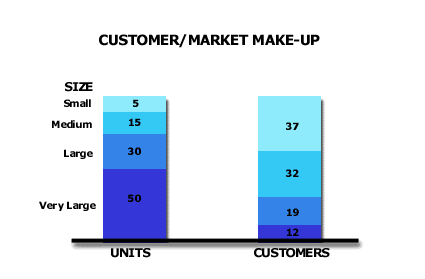Analysis 5: Customer Size Breakdown
EXHIBITS:

| HOW TO INTERPRET THE ANALYSIS: In this illustration, the Very Large Customers in the market represent 12% of the customers, but they purchase 50% of the market's total volume. Large Customers represent 19% of the customers in the market, but this customer segment purchases 30% of the total industry unit volume. The Medium Customer segment represents 32% of the total number of customers who, in turn, purchase 15% of the total units sold in the industry. Small Customers represent 37% of the customers and purchase 5% of the total industry volume.
Customer Size: Industry Examples » PURPOSE: This segmentation is the first segmentation by volume. It separates the customers into size categories and identifies those customers who have the most influence on sales volumes in the industry. This segmentation will form part of the basis for the determination of the company's target marketplace, especially for new customers.
APPROACH: The company lists all potential customers, whether or not each is currently a customer. The company estimates the number of units each customer buys or uses yearly. If necessary, the company can use a dollar value of unit volume rather than units. The company may also do a random sample from a full list of customers if it cannot get an estimate for each customer in a timely fashion. It is important in this analysis to count, as a customer, only the final buying location. The customer should not be listed only by company, but by each location of the company that makes the final decision to purchase the product. The company performs this analysis for each buying location of the customer. If the customer's buying decision is centralized, there is only one location per customer. However, in the much more common case, where the customer's buying decisions are standardized, the customer has multiple buying locations. One location may qualify the company for the approved supplier list, and another location, or several other locations, determines the quantity bought, the timing of purchases and the supplier from whom purchases will be made. The company should sort all customers by size of each customer's total purchases in the market, using the customer's final buying location as the basis for the customer's size. List the customers from largest to smallest in units or volume purchased. Starting with the largest customers, cumulate the industry sales. Break the customer list at the point at which the cumulative industry sales of all the customers in the group equal 50% of the industry sales. This group is the Very Large (VL) customer segment. Create a second group, where that group accounts for the next 30% of industry sales. These customers make up the Large (L) customer segment. The third group makes up the next 15% of industry sales, and the final group would be made up of the last 5% of industry sales. These latter two groups of customers are the Medium (M) and Small (S) customer segments, respectively. Customer Size Segments: Industry Examples » The objective of this analysis is to forecast the future using the experience of the past. If the past is not a good indicator of each of the Very Large and Large customers' average expected performance in the coming years, then the company should either use a different set of averages or evaluate each of those substantial customers individually. Test Your Knowledge: Size of Customer >> Return to Diagnose Segments: Size of Customer |
|
Recommended Reading |
| For a greater overall perspective on this subject, we recommend the following related items:
Analyses: Symptoms and Implications: Symptoms developing in the market that would suggest the need for this analysis.
Perspectives: Conclusions we have reached as a result of our long-term study and observations.
|
